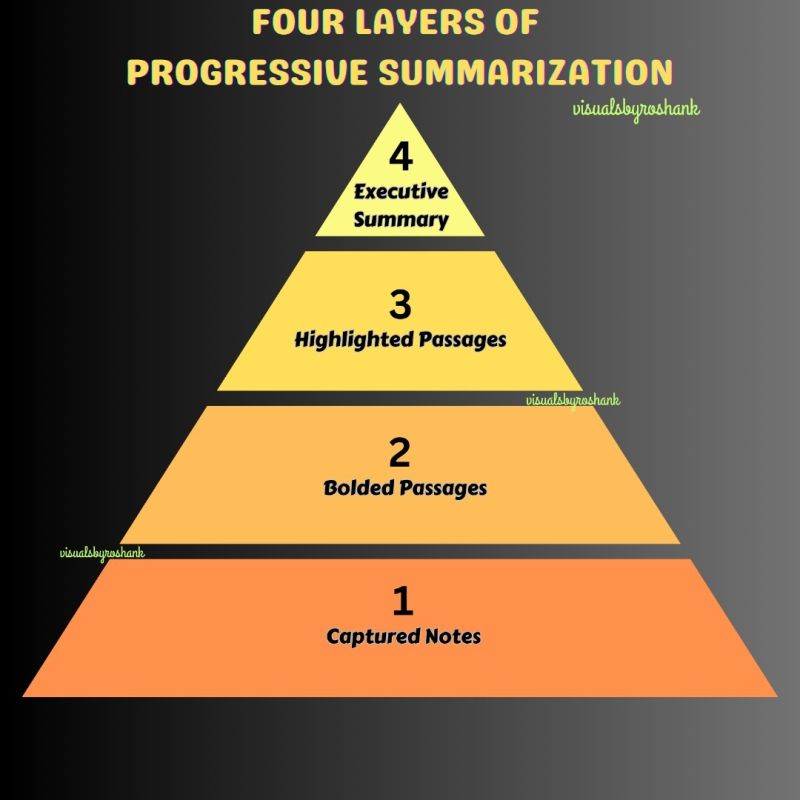
Summary
Notes from “Building a Second Brain” by Tiago Forte.
Lean towards creating through expressing knowledge rather than collecting information which isn’t put to use. By creating (expressing through distillment) content you will gain a better understanding of it.
Use a currators perspective. This is similar to the cultivation mentality for Zettelkastens.
Favorite Quotes
creativity is always a remix of exisiting parts.
Engineer Luck by cultivating the second brain.
Notes
Commonplace Books
Wow, I hadn’t heard of this before and I want to learn more. Love the historical context about how people took notes/journals hundreds of years ago. This would involve much more interaction with the study material than how I typically do it today.
Almost like artists working with a medium, it’s not just taking notes, it reshaping, restructuring, copying writing (with an analog instrument).
On the spectrum of information and collectors fallacy and information synthesis, this is the left, and audiobooks might be on the far right?
Commonplace books were notebooks or journals that individuals used to collect and organize a wide range of information, such as quotes, passages, ideas, and observations. These books were popular in Europe from the Renaissance through the 19th century and served as a means of personal record-keeping and intellectual exploration.
Second Brain Superpowers
- makes idea concrete
- reveals new associations between ideas
- incubates ideas over time
- sharpens perspectives
CODE Method - Capture, Organize, Distill, Express
- Capture: Keep what resonates
- Organize: Save for actionability
- Distill: Find the essense
- Express: Show your work
Capture: Keep what Resonates
Does it inspire me? Is it useful? Is it personal? Is it surprising?
Dont make a replica of the content. Keep a note/excerpt and link to the original. Keeping the original in its entirety doesn’t create knowledge, it’s just hoarding, similar to online bookmarking becomes just a way towards the collector’s fallacy.
12 Problems
Keep a list of problems close at hand/in mind. Apply new learnings to see how it can move those problems forward.
Second Brain uses the anecdote from Richard Feynman.
Examples from the book:
- How do I live less in the past and more in the present?
- How do I build a investment strategy that is aligned with my mid-term and long-term goals and commitments?
- What does it look like to move from mindless consimption to mindful creation?
- How can my industry become more ecologically sustainable while remaining profitable?
- How can I work through the fear I have of taking on more responsibility?
- How can I make decisions with more confidence?
Organize: Save for actionability
Cathedral Effect – the environment we’re in powerfully shapes our thinking.
This struck me as profound, and had me thinking again back to office/team culture. Does where you work shapre your thinking? Absolutely!
PARA Projects, Areas, Resources, Archives
Something that Tiago recommends: when taking notes, try to take them within the context of a active shortterm Project. This will inherently make the information more recallable, since it comes with the short term project context. If it doesn’t fit in a project then move it to an Area or Resource.
- Projects: short term efforts
- Areas: long term responsibilities
- Resources: topics or interests that may be helpful in the future
- Archive: inactive items from the other 3 categories.
Distill: find the essense
Progressive Summarization

To me, this is the synthesis part of the process. Copy the source. Then poke it with highlights and bolding to emphasize the main ideas. Write a summary for yourself at the top.
Break down note taking into 4 levels of summarization. Cultivate the information into higher levels of summarization. Doing so aids in working with the content and provides searchability.
- Capture the raw note
- Bold interesting passages
- Highlight passages
- Write a summary
(I should be doing this in the zettelkasten)
Express: Show your work
The art of creative execution
Archipelago of Ideas – stepping stones. a chain of ideas, and you fill in the gaps.
Hemingway Bridge – he would end a writing session only when he knew what idea came next instead of exhausting every idea. The next time he sat down to work he knew what he needed to do.
- write down ideas for next steps
- write down the current status
- write down and deatils you have in mind that are likely to be forgotten once you step away.
- Write out your intentinos ffor the next work session.
The essential habits of digital organizers
- Project Checklist: Kickoffs and Completions
- Weekly and Monthly Reviews: review your work to check for changes to habits/process.
- Noticing Habits: cultivate/reorg notes. (like a GC cycle for second brain?). “engineer luck”.








